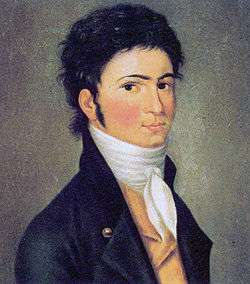Piano Trio, Op. 11 (Beethoven)
| Piano Trio | |
|---|---|
| "Gassenhauer" | |
| by Ludwig van Beethoven | |
 Beethoven in 1801, portrait by Carl Traugott Riedel | |
| Key | B-flat major |
| Catalogue | Op. 11 |
| Composed | 1797 |
| Dedication | Maria Wilhelmine von Thun |
| Published | 1798 |
| Movements | three |
| Scoring |
|
The Piano Trio in B-flat major, Op. 11,[lower-alpha 1] was composed by Ludwig van Beethoven in 1797 and published in Vienna the next year. It is one of a series of early chamber works, many involving woodwind instruments because of their popularity and novelty at the time. The trio is scored for piano, clarinet (or violin), and cello (sometimes substituted by bassoon). The key of B-flat major was probably chosen to facilitate fast passages in the B-flat clarinet, which had not yet benefited from the development of modern keys systems (such as the Albert system or Boehm system). Beethoven dedicated the piece to Countess Maria Wilhelmine von Thun.
The work is also sometimes known by the nickname "Gassenhauer Trio". This arose from its third movement which creates nine variations from a theme from the then popular dramma giocoso L'amor marinaro ossia Il corsaro (15 October 1797, Wiener Hoftheater) by Joseph Weigl. This particular melody, "Pria ch'io l'impegno" ("Before I go to work"), was so popular it could be heard in many of Vienna's lanes ("Gasse" in German). A "Gassenhauer" usually denotes a (normally simple) tune that many people (in the Gassen) have taken up and sing or whistle for themselves, the tune as such having become rather independent from its compositional origins. A rare word in contemporary German, rough modern equivalents of the term include "hit" (success) or "schlager". Other composers who used this melody include Joseph von Eybler, Johann Nepomuk Hummel and Niccolò Paganini.
Because of its unique scoring in Beethoven's output, there is some uncertainty as to whether to include it in the ordinal numbering of Beethoven's piano trios. Some assign it "No. 4" between the Op. 1 and Op. 70 sets while others leave the work out of the numbering.
Structure
The trio is in three movements:
- Allegro con brio
- Adagio
- Tema con variazioni ("Pria ch'io l'impegno": Allegretto)
References
- Notes
- ↑ Grove Music Online defines 'Piano trio' as 'A composition for piano and two other instruments, usually violin and cello; standard variants include piano with [...] clarinet and cello (Beethoven op.11 and Brahms op.114)[...].
- Sources
- Cooper, Barry (2000). Beethoven. United States: Oxford University Press. ISBN 0191592706.
- Schwartz, Steve (1996). "Review - Beethoven: Piano Trios "Archduke" & "Gassenhauer"". Classical.Net.
- Mehta, Nuvi (2017). "Program Note: Trio for Clarinet, Cello & Piano in B-flat major, Op. 11" (PDF). San Diego Symphony Orchestra.
- Watson, Angus (2012). Beethoven's Chamber Music in Context. Woodbridge: Boydell Press. ISBN 978-1-84383-716-9.
External links
- Piano Trio in B-flat major, Op. 11: Scores at the International Music Score Library Project (IMSLP)
- Performance of Piano Trio, Op. 11 by the Eroica Trio from the Isabella Stewart Gardner Museum in MP3 format
- Beethoven: Piano Trio No. 4 in B-flat major Op.11 "Gassenhauer Trio" 1st movement on YouTube, Satomi Hayakawa (Piano), Yasutaka Takeuchi (Cello), Chihiro Inda (Violin)
- Third movement on YouTube, Oscine Trio